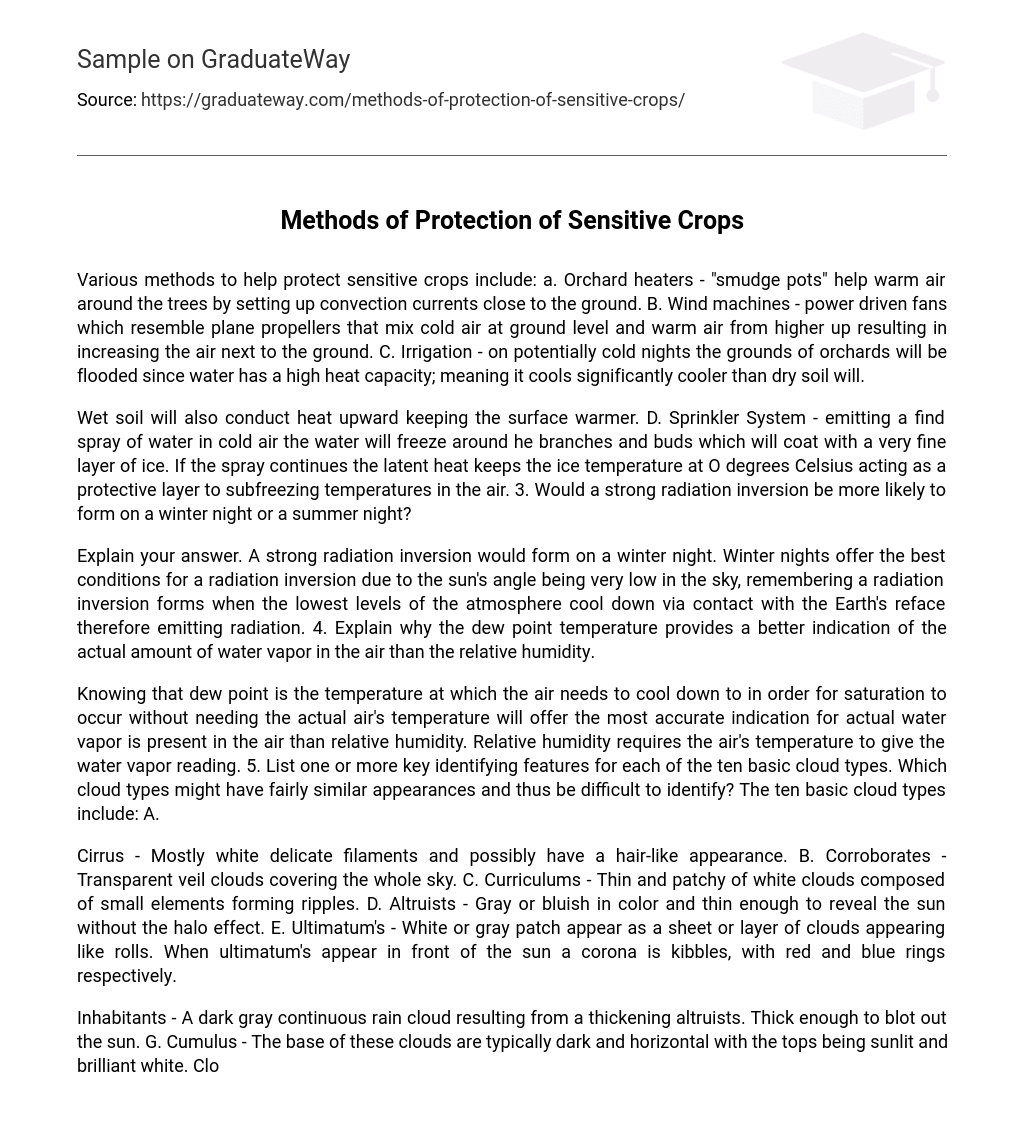Various methods to help protect sensitive crops include: a. Orchard heaters – “smudge pots” help warm air around the trees by setting up convection currents close to the ground. B. Wind machines – power driven fans which resemble plane propellers that mix cold air at ground level and warm air from higher up resulting in increasing the air next to the ground. C. Irrigation – on potentially cold nights the grounds of orchards will be flooded since water has a high heat capacity; meaning it cools significantly cooler than dry soil will.
Wet soil will also conduct heat upward keeping the surface warmer. D. Sprinkler System – emitting a find spray of water in cold air the water will freeze around he branches and buds which will coat with a very fine layer of ice. If the spray continues the latent heat keeps the ice temperature at O degrees Celsius acting as a protective layer to subfreezing temperatures in the air. 3. Would a strong radiation inversion be more likely to form on a winter night or a summer night?
Explain your answer. A strong radiation inversion would form on a winter night. Winter nights offer the best conditions for a radiation inversion due to the sun’s angle being very low in the sky, remembering a radiation inversion forms when the lowest levels of the atmosphere cool down via contact with the Earth’s reface therefore emitting radiation. 4. Explain why the dew point temperature provides a better indication of the actual amount of water vapor in the air than the relative humidity.
Knowing that dew point is the temperature at which the air needs to cool down to in order for saturation to occur without needing the actual air’s temperature will offer the most accurate indication for actual water vapor is present in the air than relative humidity. Relative humidity requires the air’s temperature to give the water vapor reading. 5. List one or more key identifying features for each of the ten basic cloud types. Which cloud types might have fairly similar appearances and thus be difficult to identify? The ten basic cloud types include: A.
Cirrus – Mostly white delicate filaments and possibly have a hair-like appearance. B. Corroborates – Transparent veil clouds covering the whole sky. C. Curriculums – Thin and patchy of white clouds composed of small elements forming ripples. D. Altruists – Gray or bluish in color and thin enough to reveal the sun without the halo effect. E. Ultimatum’s – White or gray patch appear as a sheet or layer of clouds appearing like rolls. When ultimatum’s appear in front of the sun a corona is kibbles, with red and blue rings respectively.
Inhabitants – A dark gray continuous rain cloud resulting from a thickening altruists. Thick enough to blot out the sun. G. Cumulus – The base of these clouds are typically dark and horizontal with the tops being sunlit and brilliant white. Clouds are dense with sharp outlines developing vertically in the form of rising mounds, domes, or towers with bulging upper parts. H. Stratus – Gray layer with uniform base which has the ability, if thick enough, to produce drizzle, ice prisms, or snow grains. The sun is visible through the cloud with a distinctive outline.
Cumulonimbus – The typical thunderstorm cloud which is heavy and dense which looks like a mountain or large tower. Upper portion is typically smooth and the underbelly is often dark with low ragged clouds. These clouds produce precipitation, hail, and tornadoes. Streptococcus – Gray or whitish patch, sheet, or layered cloud with a honeycomb appearance or rolls. Stratus and Corroborates are fairly similar although are easily discernible by the halo effect of the sun or moon found in the corroborates clouds. Earns, C. D. (2015). Essentials of Meteorology: An Invitation to the Atmosphere,Seventh Edition. Stamford: Coinage Learning.





